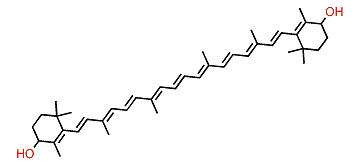
| beta,beta-Carotene-4,4'-diol |
| Formula: | C40H56O2 |
| CAS#: | 29065-03-0 |
| MW: | 568.87 |
[MS]
|
|
Species utilize beta,beta-Carotene-4,4'-diol in its chemical communication system
| Amphilepidida, Amphiuridae | |
| Amphiura filiformis |
P
¦Category of the chemical signal
| A - | Attractant |
| Al - | Allomone |
| K - | Kairomone |
| P - | Pheromone |
| Sy - | Synomone¦ |
|
¦(*) indicates that compound is active¦
|
Dwarf brittle star |
| |
| Amphilepidida, Ophiopholidae | |
| Ophiopholis aculeata |
P
¦Category of the chemical signal
| A - | Attractant |
| Al - | Allomone |
| K - | Kairomone |
| P - | Pheromone |
| Sy - | Synomone¦ |
|
¦(*) indicates that compound is active¦
|
Daisy brittle star |
| |
| Amphilepidida, Ophiotrichidae | |
| Ophiothrix fragilis |
P
¦Category of the chemical signal
| A - | Attractant |
| Al - | Allomone |
| K - | Kairomone |
| P - | Pheromone |
| Sy - | Synomone¦ |
|
¦(*) indicates that compound is active¦
|
Common brittle star |
| |
| Aspidochirotida, Stichopodidae | |
| Stichopus regalis |
P
¦Category of the chemical signal
| A - | Attractant |
| Al - | Allomone |
| K - | Kairomone |
| P - | Pheromone |
| Sy - | Synomone¦ |
|
¦(*) indicates that compound is active¦
|
Royal sea cucumber |
| |
| Diadematoida, Diadematidae | |
| Diadema savignyi |
P
¦Category of the chemical signal
| A - | Attractant |
| Al - | Allomone |
| K - | Kairomone |
| P - | Pheromone |
| Sy - | Synomone¦ |
|
¦(*) indicates that compound is active¦
|
Savigny’s hatpin urchin |
| |
| Holothuriida, Holothuriidae | |
| Holothuria tubulosa |
P
¦Category of the chemical signal
| A - | Attractant |
| Al - | Allomone |
| K - | Kairomone |
| P - | Pheromone |
| Sy - | Synomone¦ |
|
¦(*) indicates that compound is active¦
|
Tubular sea cucumber |
| |
| Lecanorales, Cladoniaceae | |
| Cladia aggregata |
P
¦Category of the chemical signal
| A - | Attractant |
| Al - | Allomone |
| K - | Kairomone |
| P - | Pheromone |
| Sy - | Synomone¦ |
|
¦(*) indicates that compound is active¦
|
Common coral lichen |
| |
| Pollicipedomorpha, Pollicipedidae | |
| Pollicipes polymerus |
P
¦Category of the chemical signal
| A - | Attractant |
| Al - | Allomone |
| K - | Kairomone |
| P - | Pheromone |
| Sy - | Synomone¦ |
|
¦(*) indicates that compound is active¦
|
Gooseneck barnacle |
| |
| Spatangoida, Spatangidae | |
| Spatangus purpureus |
P
¦Category of the chemical signal
| A - | Attractant |
| Al - | Allomone |
| K - | Kairomone |
| P - | Pheromone |
| Sy - | Synomone¦ |
|
¦(*) indicates that compound is active¦
|
Purple heart urchin |
| |
| Verongiida, Aplysinidae | |
| Aplysina aerophoba |
P
¦Category of the chemical signal
| A - | Attractant |
| Al - | Allomone |
| K - | Kairomone |
| P - | Pheromone |
| Sy - | Synomone¦ |
|
¦(*) indicates that compound is active¦
|
Gold sponge |
| |
| Aplysiida, Aplysiidae, Aplysiinae | |
| Aplysia depilans |
P
¦Category of the chemical signal
| A - | Attractant |
| Al - | Allomone |
| K - | Kairomone |
| P - | Pheromone |
| Sy - | Synomone¦ |
|
¦(*) indicates that compound is active¦
|
Depilatory sea hare |
| Aplysia fasciata |
P
¦Category of the chemical signal
| A - | Attractant |
| Al - | Allomone |
| K - | Kairomone |
| P - | Pheromone |
| Sy - | Synomone¦ |
|
¦(*) indicates that compound is active¦
|
Sooty sea hare |
| Aplysia rosea |
P
¦Category of the chemical signal
| A - | Attractant |
| Al - | Allomone |
| K - | Kairomone |
| P - | Pheromone |
| Sy - | Synomone¦ |
|
¦(*) indicates that compound is active¦
|
Small rosy sea hare |
| |
| Comatulida, Antedonidae, Antedoninae | |
| Antedon petatus |
P
¦Category of the chemical signal
| A - | Attractant |
| Al - | Allomone |
| K - | Kairomone |
| P - | Pheromone |
| Sy - | Synomone¦ |
|
¦(*) indicates that compound is active¦
|
Featherstar |
| |
| Spatangoida, Loveniidae, Echinocardiinae | |
| Echinocardium cordatum |
P
¦Category of the chemical signal
| A - | Attractant |
| Al - | Allomone |
| K - | Kairomone |
| P - | Pheromone |
| Sy - | Synomone¦ |
|
¦(*) indicates that compound is active¦
|
Common heart-urchin |
| |
|







